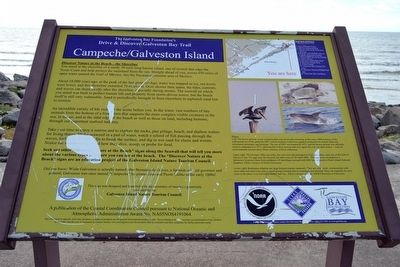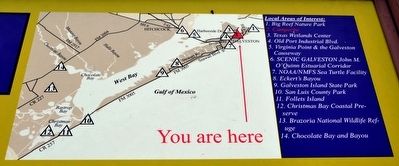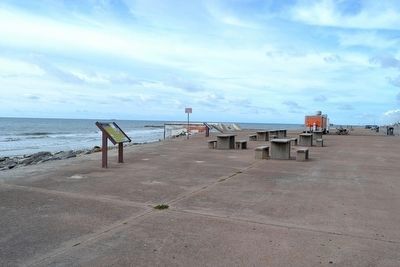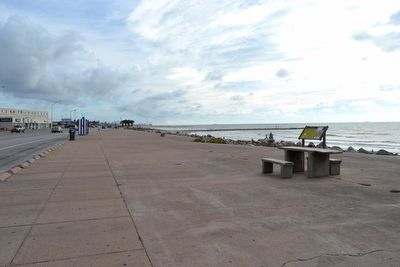Galveston in Galveston County, Texas — The American South (West South Central)
Campeche / Galveston Island
The Galveston Bay Foundationís Drive & Discover Galveston Bay Trail
Discover Nature at the Beach ... the Shoreline
You stand at the shoreline of a sandy 30-mile long barrier island, one of several that edge the Texas Coast and help protect the mainland from the sea. Straight ahead of you, across 650 miles of open water named the Gulf of Mexico, lies the Yucatan peninsular area of Mexico.
About 18,000 years ago, at the peak of the last great Ice Age, water was trapped as ice, sea levels were lower, and this shoreline extended 70 miles out. Over shorter time spans, the tides, currents, and waves can dramatically alter the shoreline, especially during storms. The seawall on which you stand was built to protect human life and property from storm-driven waves, but the beach itself is still very vulnerable. Sand is periodically brought in from elsewhere to replenish sand lost to erosion.
An incredible variety of life exists in the scene before you. In the water, vast numbers of tiny animals form the bottom of a food chain that supports the more complex visible creatures in the sea, in the air, and at the tidal edge of the beach as well as those on land, including humans, through our important seafood industry.
Take your time to enjoy a sunrise and to explore the rocks, pier pilings, beach, and shallow waters for living things. Shake seaweed in a pail of water, watch a school of fish passing through the waves, look for a dolphin fin to break the surface, and dig in wet sand for clams and worms. Notice the variety of birds, and how they dive, scoop, or probe for food.
Seek out other “Discover Nature at the Beach” signs along the Seawall that will tell you more about the various types of nature you can see at the beach. The “Discover Nature at the Beach” signs are an educational project of the Galveston Island Nature Tourism Council.
Did you know: While Galveston is actually named after Bernardo de Galvez, a Spanish colonial governor and general, Galveston was once named “Campeche” by pirates Jean and Pierre Lafitte in the early 1800s!
Photos
Left: The brown pelican, a now common bird, was faced with extinction in the early 1960s because of the widespread use of the pesticide DDT, which resulted in defective eggshell production by female birds and subsequent premature egg breakage. The use of DDT was banned in 1972, and the brown pelican was officially listed as endangered in 1973, allowing this bird to recover and once again fly over our open waters -- truly an environmental success story. Photo courtesy of Dean Johnstone.
Upper right: This Kempís ridley sea turtle, the most rare and endangered of all sea turtles,
came out of the Gulf of Mexico to lay 116 egges near the Seawall just after noon on 28 April 2006. The eggs were incubated in a laboratory to protect them from predators; 89 hatchlings emerged and were later released at Padre Island National Seashore. Photo courtesy of NOAA Galveston.
Lower right: Bottlenose dolphins are large-brained marine mammals. They are very social, communicate with each other and tend to be seen in small groups hunting fish or seemingly just playing. They can regularly be seen close to the shore or in Galveston harbor and bay. Photo courtesy of Texas A&M University at Galveston.
Topics. This historical marker is listed in this topic list: Natural Features.
Location. 29° 16.388′ N, 94° 48.865′ W. Marker is in Galveston, Texas, in Galveston County. Marker can be reached from Seawall Boulevard, 0.3 miles east of 53rd Street, on the right when traveling east. Touch for map. Marker is in this post office area: Galveston TX 77551, United States of America. Touch for directions.
Other nearby markers. At least 8 other markers are within walking distance of this marker. The Birds of Galveston (a few steps from this marker); Galveston Seawall and Grade Raising (within shouting distance of this marker); American Red Cross, Galveston County Chapter (within shouting distance of this marker); The Original Galveston Seawall (about 300 feet away, measured in a direct line); Beach Invertebrates (about 400 feet away); Peter Leroy Colombo (approx. 0.6 miles away); Burial Site of David G. Burnet (1788-1870) (approx. 0.6 miles away); The Rev. Henry P. Young (approx. 0.7 miles away). Touch for a list and map of all markers in Galveston.
More about this marker. As noted on the marker, the sign is “A publication of the Coastal Coordination Council pursuant to National Oceanic and Atmospheric Administration Award No. NA05NOS4191064” and “was designed and installed with the assistance of resources generously provided by the Galveston Island Nature Tourism Council”.
Credits. This page was last revised on June 16, 2016. It was originally submitted on November 16, 2015, by Duane Hall of Abilene, Texas. This page has been viewed 1,136 times since then and 136 times this year. Photos: 1, 2, 3, 4, 5. submitted on November 16, 2015, by Duane Hall of Abilene, Texas.




